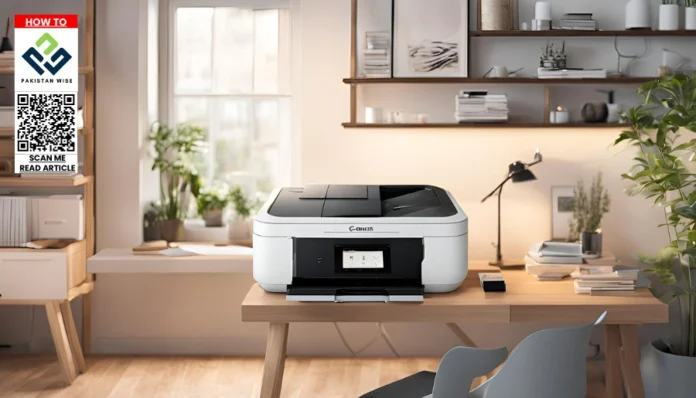Before embarking on the setup process of your Canon printer, gaining a clear understanding of its features and functioning is a crucial first step. This knowledge will make the setup process more straightforward and ensure smooth operation of your device.
Features of Your Canon Printer
Canon printers boast several cutting-edge features designed to simplify your printing needs and increase productivity. Here are some notable features that come with most Canon printers:
- Wireless Connectivity: Many Canon printers come with Wi-Fi ability, allowing for wireless printing from your computer, smartphone, or tablet. This feature removes the need for wires and gives you the freedom to print from anywhere within your Wi-Fi interface.
- Double-sided Printing: This feature, also known as duplex printing, aids in conserving paper by printing on both sides. It is particularly useful for printing large documents.
- High Printing Speed: Canon printers are renowned for their high-speed printing capacity, which improves efficiency, particularly for high-volume printing tasks.
- Fine Print Technology: This feature enhances the quality of prints, making Canon printers ideal for printing high-definition images and fine details.
Functioning of Your Canon Printer
On a basic level, the workflow of Canon printers entails three key stages: receiving data, processing data, and printing data.
- Receiving Data: The printer receives the printing commands and associated data from your device. This can be transmitted wirelessly or via a USB cable, depending on your printer model and setup.
- Processing Data: The printer processes this received data using its inbuilt processor and memory. It interprets the instructions related to page layout, font style, color distribution, etc.
- Printing Data: Upon processing the data, the printer precisely dispenses ink from the cartridges onto the paper, translating the digital information into a physical, printed format. The printer then ejects the completed printed sheet, ready for use.
Understanding these features and functioning processes of your Canon printer will better prepare you for the setup process, ensuring an efficient and hassle-free experience.
Basic Requirements for Connecting Canon Printer to Wifi
Setting up Canon printer to connect to WiFi requires certain pre-requisites. The following would serve as a checklist to ensure both your Canon printer and the necessary equipment are ready for the WiFi connection process.
Working WiFi Connection
Having a working WiFi connection is the primary requirement. It’s advisable to test your WiFi connection using a device such as a computer or a smartphone to confirm its stability before connecting your Canon printer. Ensure also that your WiFi is not closed or restricted, i.e., it should allow new devices (in this case, a Canon printer) to connect.
WiFi Network Details
Securing and remembering your WiFi network details is a must. This includes the WiFi username (also known as the Network SSID) and the password (also termed as the Network Key). The Network SSID and Network Key are usually found at the back of your WiFi router. You’ll need these to provide access for your Canon printer to connect to your network.
WiFi-Enabled Canon Printer
Before attempting to connect, ensure that your Canon printer supports WiFi connectivity. Not all printers come with this feature, particularly older models. The printer’s specifications or user manual can provide this information. If the printer supports WiFi, a wireless icon or a WiFi logo would typically be displayed on the printer’s control panel.
Checklist before Starting the Process
- Ensure a stable WiFi connection.
- Secure the WiFi username (Network SSID) and WiFi password (Network Key).
- Confirm your printer supports WiFi connectivity.
Once all these criteria are met, you are ready to connect your Canon printer to your WiFi network.
Understanding Wifi Connections: Setting Up Your Printer
In order to set up your printer on your wifi network successfully, a basic understanding of wifi connections is essential. A wifi network provides access to the internet wirelessly, connecting devices like computers, smartphones, smart TVs, and printers without the need for physical cables. Two key terms related to wifi networks are SSID and WPA.
SSID
The Service Set Identifier (SSID) is essentially the name of a wifi network, which you see when scanning for available networks on your device. When setting up a printer or any device, you need to find and select the correct SSID from the list of available networks.
WPA
Wifi Protected Access (WPA) is a technology designed to secure wireless networks. It encrypts data transmitted over the network, making it difficult for unauthorized individuals to gain access. When connecting a device to your wifi network, you will typically be asked for the WPA password (often just called the wifi password).
Troubleshooting Wifi Connections
If you encounter issues when attempting to connect your printer to your wifi network, the following steps may be helpful:
- Check Your SSID: Ensure you have selected the correct SSID. Similar or duplicate network names can lead to errors.
- Confirm Your Password: Check if your WPA password is correct. Remember that passwords are case-sensitive.
- Reset Your Router: Sometimes, simply restarting or resetting your router can resolve connection issues.
- Update Firmware: Check for firmware updates for your router, as outdated firmware can cause connectivity problems.
- Printer Proximity: Make sure your printer is not too far from the wifi router, as distance can affect signal strength.
- Interference: Other electronics and physical obstacles like walls can affect wifi signals. Removing these barriers can improve connection quality.
Understanding the basics of wifi connections and troubleshooting can make it easier to set up your printer and maintain a stable, secure home network.
Canon Printer Wifi Setup Guide
Connecting a Canon printer to your Wifi network involves a series of steps which we’ll walk you through below. These steps should work on printers with a touchscreen as well as older models without. We’ll cover the process for both Windows and Mac operating systems.
Canon Printer Wifi Setup: Touchscreen Models
- Start by powering on your Canon printer and make sure it’s in ‘Wireless LAN Network’ mode. You can do this by pressing the ‘Setup’ button, followed by the ‘Wireless LAN Setup’ option.
- On the printer’s touch screen, select ‘Other Setup’, then ‘Cableless Setup’.
- On your computer, install the Canon printer driver and software. If you don’t have the driver, you can download it from the Canon’s official website.
- During the installation process, select ‘Wireless LAN Connection’ as the connection method and make sure your printer is connected to the same network as your computer.
Canon Printer Wifi Setup: Non-Touchscreen Models
- Switch on your Canon printer and make sure it’s in ‘Wireless LAN Network’ mode. This can be done by pressing and holding the ‘Wifi’ button until the power light starts flashing.
- Press the ‘Color’ button, followed by the ‘Wifi’ button. Make sure the Wifi light flashes quickly and the power light is lit.
- On your computer, install the Canon printer driver and software exactly like the process in the touchscreen models setup.
- During the installation, select ‘Wireless LAN Connection’. Ensure your printer and computer are connected to the same network.
Setup on Windows
To install the printer driver and software on a Windows-based PC, navigate to the Canon website and download the relevant driver for your printer model. Then, simply run the installer and follow the on-screen instructions, making sure to select ‘Wireless LAN Connection’ when prompted.
Setup on Mac
If you are a Mac user, the process is almost identical. Navigate to the Canon website and download the Mac version of your printer’s driver. Run the installer and follow the on-screen instructions, again ensuring ‘Wireless LAN Connection’ is selected when prompted.
Troubleshooting
If you encounter any issues while attempting to connect your Canon printer to your Wifi network, always double-check the following:
- Your printer is indeed switched on and in ‘Wireless LAN Network’ mode.
- Your printer and computer are both connected to the same Wifi network.
- The Canon printer driver and software are properly installed on your computer.
Common Issues in Wi-Fi Setup and Their Solutions
Even with a comprehensive guide, setting up Wi-Fi can sometimes present unforeseen complications. Below, we cover some common hiccups and provide potential solutions to aid in the Wi-Fi setup process.
1. Unable to Connect to the Network
This is one of the most common issues one may encounter during Wi-Fi setup. There can be many reasons behind this error, ranging from incorrect login credentials to network congestion. Should you encounter this issue:
- First, check if the passphrase has been entered correctly.
- If the issue persists, try to reboot your router and your device.
- An advanced step would be to change the channel of your Wi-Fi on your router settings as congested channels can also lead to connection issues.
2. Weak Signal Strength
Weak signal strength can often lead to slow internet speed or even dropped connections. To mitigate this issue:
- Ensure that the router is placed in a central location, away from barriers and devices that could produce interference.
- You might also consider investing in a Wi-Fi range extender to boost the signal strength.
3. Network Overload
If too many devices are connected to your Wi-Fi network, it can lead to network overload, resulting in slow speed or frequent disconnections. If you suspect this is the case:
- You might need to remove some devices from the network or upgrade to a router that can handle more connections.
4. Router Firmware Outdated
Outdated router firmware can also be a root cause of many Wi-Fi setup issues. If you suspect your router’s firmware is outdated:
- Check the manufacturer’s website for updates.
- If an update is available, follow the instructions provided to update the firmware, making sure to backup your router settings first.
Remember, each Wi-Fi setup is unique and these are only general solutions. If problems persist, contact your service provider or the device manufacturer for further assistance.
Frequently Asked Questions about Printer and WiFi Setup
Setting up a printer or a WiFi network may appear as a daunting task to many. Here are some frequently asked questions (FAQs) based on common queries usually encountered during the setup process.
WiFi Setup
How do I find my WiFi network name and password?
Your network name, also known as an SSID, will typically be displayed on your router. The password is often labelled as a security key and can also be found on the router. If you’ve changed these details and forgotten them, please refer to your router’s manual or contact your service provider for assistance.
Why can’t my device connect to WiFi?
There can be several reasons, such as signal interference, the device being out of range, or incorrect network settings. Make sure your WiFi is active and you are within range. Try resetting your router or contact your service provider if the issue persists.
Printer Setup
You can connect a printer to your computer by either using the USB cable or via WiFi. After that, go to your system settings and add the device. You may need to install drivers, which are typically available on the manufacturer’s website. Refer to your printer’s manual for specific installation instructions.
There could be several issues, such as the printer being out of ink, a paper jam, or problems with the print settings. Check the print queue, ensure your printer is set as default, and that it’s not set to ‘Use printer offline’. If these steps don’t resolve your issue, try reinstalling the printer’s drivers.
Note: The instructions might differ slightly depending on the specific model of your printer, or router. Always refer to your product manual or manufacturer’s website for precise instructions.

